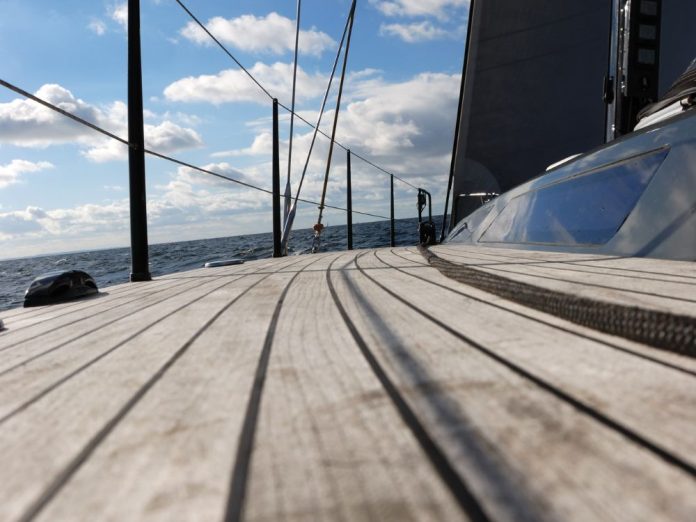Life afloat, mess included
My husband and I live onboard a 50-foot Jeanneau with our three teenagers, and Harry, our dog. She’s more than just a sailboat — she’s our home, our transport, and our escape all rolled into one.
Days can be blissfully simple: fishing off the transom for dinner, a quick swim off the bow (weather dependent), or just watching the harbour lights shift with the tide. Nights are often spent tucked deep inside the boat, listening to rain lash the dodger while we’re at anchor. She does her job well — keeping us dry, shaded, and safe — but she also takes a hammering.
A storm this winter shredded our bimini. That alone would be enough work, but birds Harry couldn’t chase off made it worse, decorating the canvas with acidic white splatters. Fish smells creep into the cushions when we rushed the clean-up after fishing. And after days of rain and humidity, mildew blooms across seams, while the once-clear windows of our dodger turned cloudy with salt.
These aren’t just small irritations. Bird droppings weaken stitching, fish oils rot fabrics, mildew strips waterproofing, and stale smells ruin the comfort of the cockpit and below. Ignore them long enough and we find we’re not just living with mess — we’re inviting health risks and big replacement costs.
Whether you live onboard like us or take your boat out regularly, or not, these stories might well resonate. And with spring fast approaching it is a timely reminder of what needs to be done.
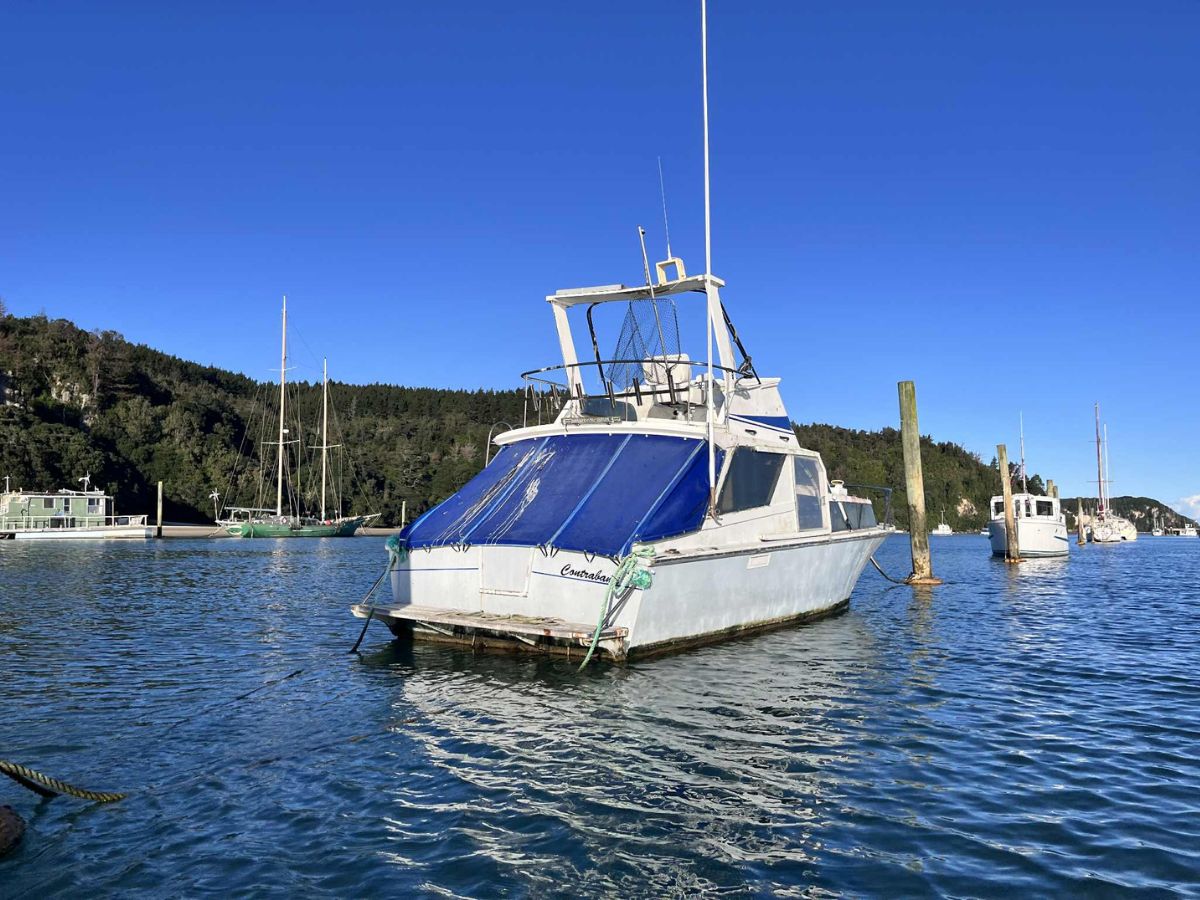
The upside? With steady care — and the right kit — you can stay ahead of the mess. From canvas and clears to upholstery, water toys, hardware, and storage, every surface has its own needs. Get them right, and life afloat stays fresh.
Canvas (biminis, dodgers, sail and boat covers)
Canvas is your shield against New Zealand’s weather roulette: sun one moment, sideways rain the next. It also cops the worst of daily life — bird droppings, salt, fish guts. When it’s fresh and taut, you don’t notice it. When it’s dirty or smelly, you notice nothing else.
Steps
A warm, dry day is always best for cleaning, but you can’t always wait for perfect weather. If you’re tidying up in damp or humid conditions, be extra careful to remove every trace of moisture so it doesn’t linger.
- Rinse with fresh water after every trip. Salt crystals gather in seams, so flush them out with a hose or bucket. Wipe over with a microfibre cloth to lift grit before it sets.
- Wash with mild soap. A few drops of dishwashing liquid in warm water does the trick. Apply with a microfibre cloth or soft brush, test a hidden patch first, and rinse thoroughly before it dries on the fabric.
- Remove bird droppings fast. Don’t let them bake in the sun. Spray with 303 Multi-Surface Cleaner and lift with a damp microfibre cloth. The longer they sit, the more stitching they eat.
- Treat lingering smells. If fish odour hangs on after a soap wash, use 303 Mould & Mildew Cleaner with a microfibre cloth, paying extra attention to seams.
- Tackle stains. For oils or food spills, blot gently with K2R Spot Lifter on a cloth. Dab, don’t rub — rubbing drives grease deeper.
- Dry completely. Stretch canvas out to dry in the open air before packing away. Damp folds are mildew’s best friend.
- Protect and waterproof. Once dry, spray evenly with 303 Fabric Guard. Wipe over with a clean cloth so water beads on top instead of soaking in.
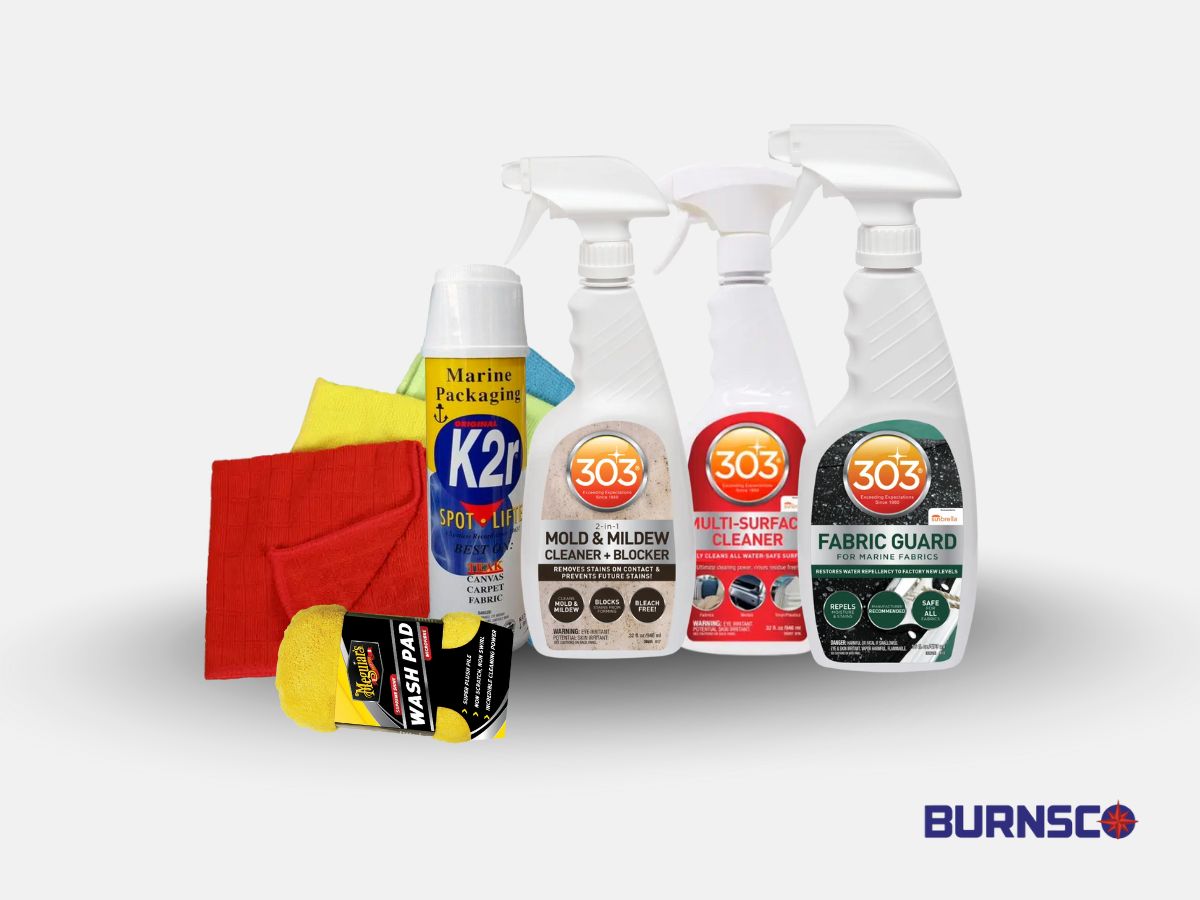
A clean, waterproofed bimini is more than just smart-looking. It’s a shield that keeps your cockpit fresh and comfortable instead of faintly smelling like last night’s kahawai. With regular rinsing and the odd treatment, your canvas will last years longer and keep life under it far more pleasant.
Clears (PVC vinyl windows, strataglass, polycarbonate)
Once the canvas is sorted, your eyes naturally fall on the clears. They’re your windows to the world — and nothing changes a cockpit more than whether you’re looking out through bright, supple panes or yellowed, scratched, musty sheets. Salt, sunscreen, and mildew all conspire against them, but with gentle care, they’ll stay clear.
Steps
- Rinse with plenty of fresh water. Let water run over the surface, then wipe lightly with a microfibre cloth. Never scrub dry salt — it’s like rubbing sandpaper on glass.
- Wash with mild soap. A few drops of dish soap in warm water, wiped with a microfibre cloth, is enough. Avoid paper towels or harsh pads that scratch.
- Dry softly. Use another clean, absorbant cloth to pat dry. Leaving water spots to bake in sun leaves marks that never quite shift.
- Tackle odours. If mildew or fish smells creep into seams, rinse with 303 Multi-Surface Cleaner, then spray 303 Mould & Mildew Cleaner. Wipe carefully into corners with a cloth.
- Polish monthly. Use a vinyl-safe polish like Vuplex or Imar. Apply with a microfibre cloth and buff until the shine returns. It adds UV and salt protection as well.
- Store rolled, not folded. Place soft cotton or microfibre cloths between layers so clears don’t stick or crease.
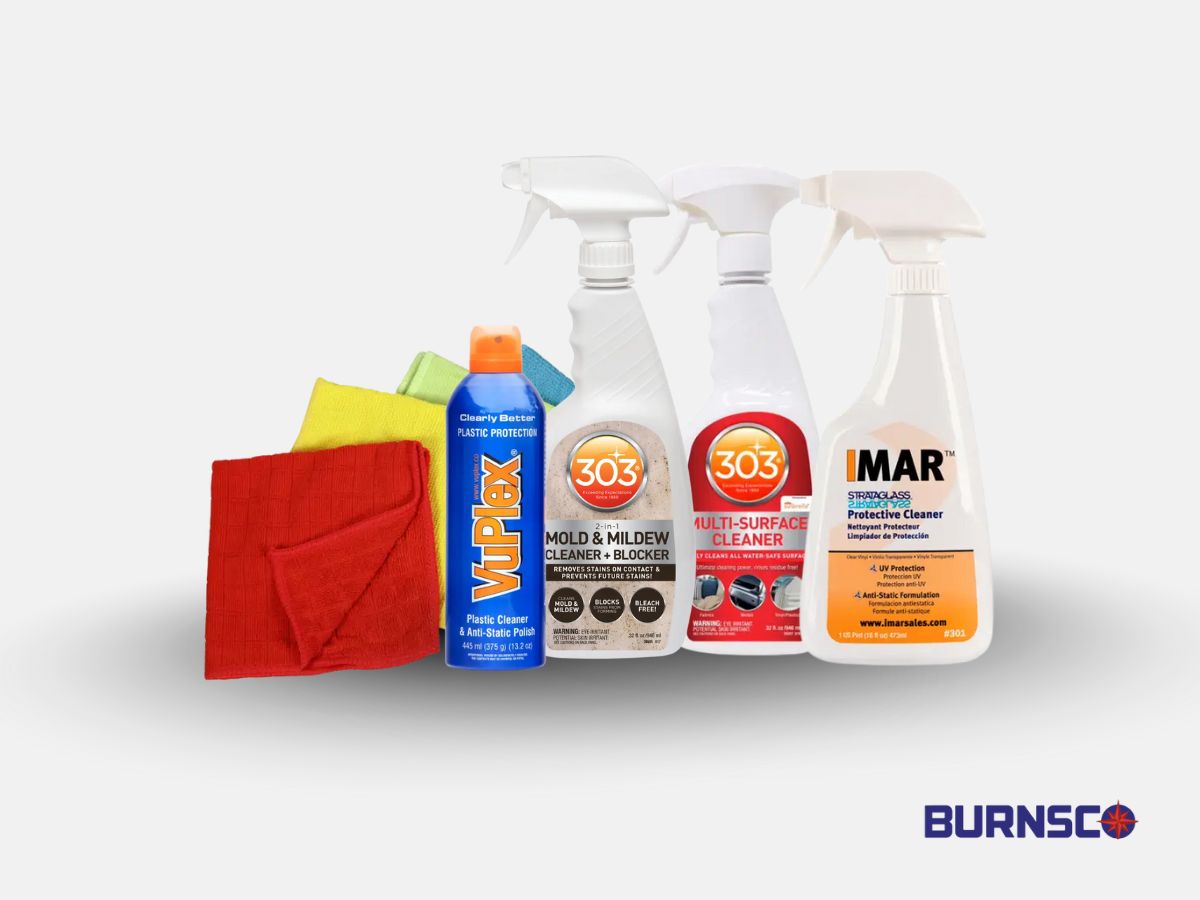
Well-kept clears don’t just keep the weather out — they transform how the boat feels. Clean, supple windows flood the cockpit with light and give you a horizon, not a haze. Look after them, and you’ll extend both their life and your own enjoyment.
Repairs (ripped canvas, holed dodgers and clears)
Even the most carefully maintained gear eventually gets damaged. A storm can rip a seam in your dodger, a careless winch handle can puncture a bimini, and clears are all too easy to nick or crack. These problems don’t just look untidy — they spread quickly if left unchecked, and they let in water, draughts, and mildew. The sooner you deal with them, the longer your gear lasts.
Steps
- Inspect regularly. Run your hand along seams and edges, feeling for weakened stitching or small tears. Early detection is easier to fix.
- Patch canvas quickly. For small rips, use a sail needle and UV-resistant thread. Back the repair with a patch of canvas and apply with double rows of stitching. Always clean the area with fresh water and a microfibre cloth before sewing.
- Temporary fixes. Canvas repair tape or patches will hold for a while, but should be seen as a stop-gap until a stronger repair is made.
- Professional resewing. If the stitching is pulling or fabric has stretched, have a canvas maker resew or replace panels. This prevents small issues turning into full replacements.
- Holed clears. For tiny punctures in vinyl or polycarbonate, use a clear patch kit or specialised marine adhesive. Larger cracks often require a replacement panel, so don’t wait too long to act.
- Prevent further stress. Once repaired, avoid folding or storing the damaged area tightly. Keep it dry and supported to help the fix hold.
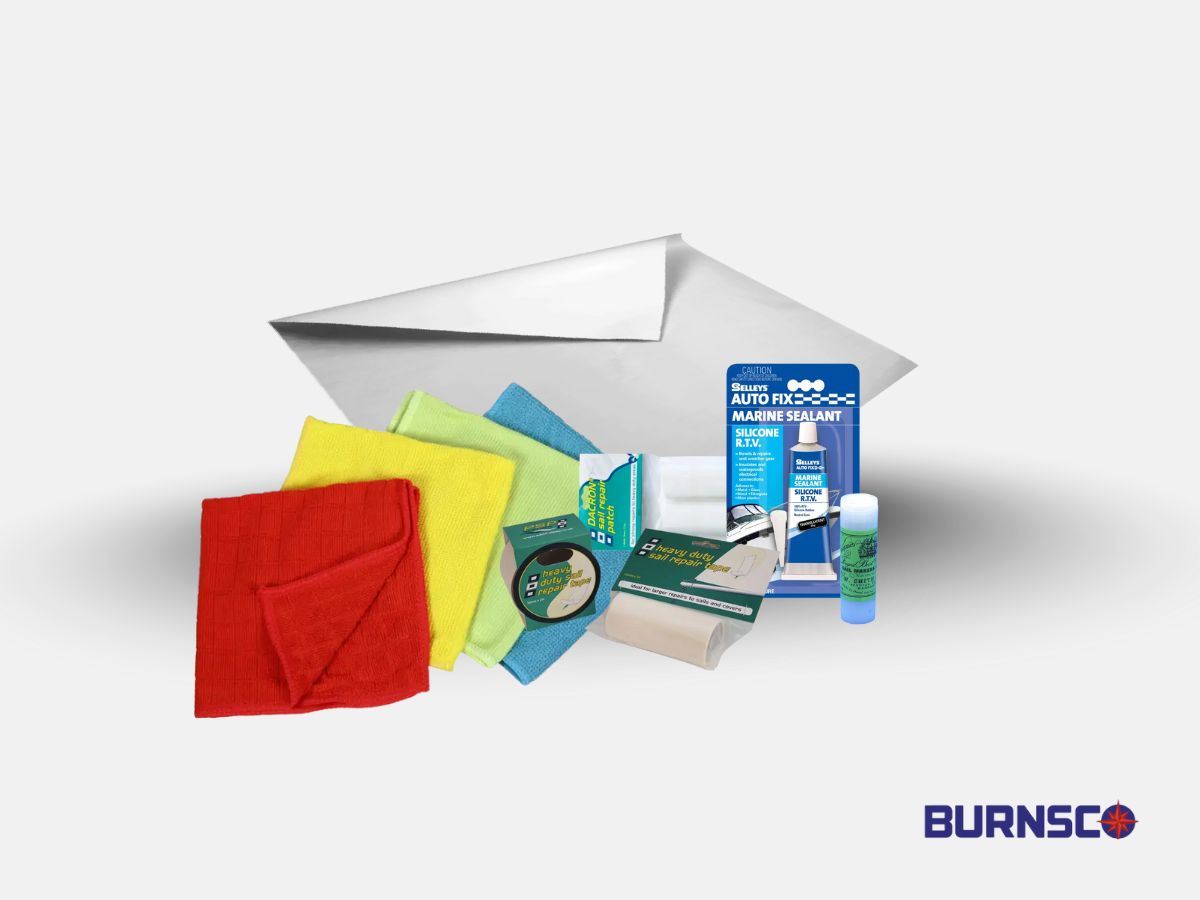
Canvas and clears are expensive, but most damage starts small. By patching early — whether with a simple repair kit or a professional resew — you can stop tears from spreading, keep water and mildew at bay, and avoid the far higher cost of replacement.
Upholstery (cockpit seats, sunpads, outdoor lounges)
If clears are the eyes, upholstery is the welcome mat. It’s where you sit for sundowners, where wet togs flop, and where sunscreen and spilled drinks soak in. Fresh, supple seats make your cockpit a living space. Neglected ones make it a place you avoid.
Steps
- Rinse after every outing or, ideally, at the end of each day. Spray with fresh water and wipe down with a microfibre cloth so salt and grime don’t get into seams.
- Monthly soap wash. Wipe with warm soapy water and a microfibre cloth, lifting dirt from stitching where it likes to gather. Rinse thoroughly and dry.
- Deal with fish smells fast. Spray 303 Multi-Surface Cleaner on a cloth and wipe vinyl or fabric. For vinyl seating, 3M Vinyl Cleaner & Protector both scrubs and leaves behind a protective layer.
- Deep clean stubborn stains. Apply Vyking Force Upholstery Spot Cleaner to marks, wait a few minutes, then blot with a clean cloth until the stain lifts.
- Air dry only. Leave cushions to dry naturally in the open. Heaters or dryers can shrink fabric or crack vinyl.
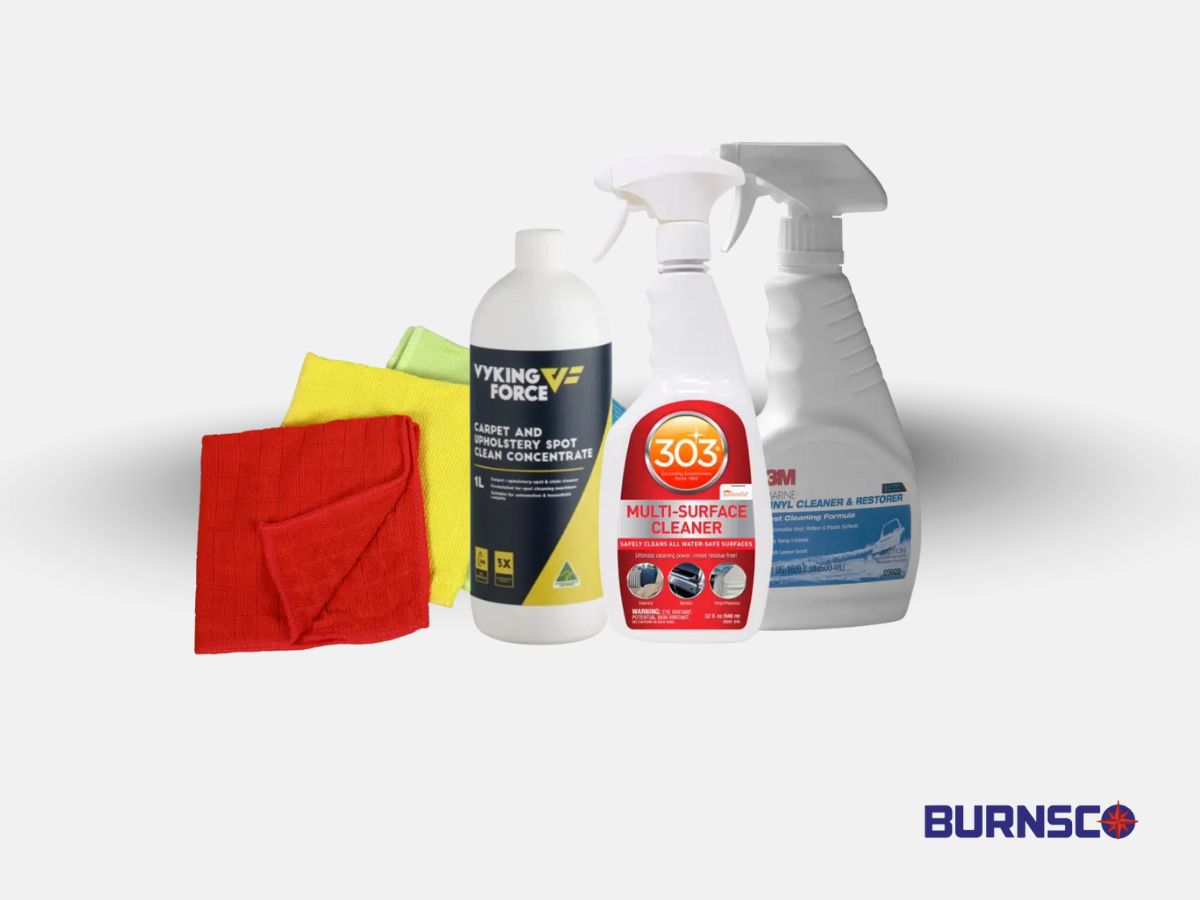
Clean upholstery keeps a boat inviting. When the seats are supple and fresh, sundowners feel like sundowners — not like perching on damp sponges. A few minutes of care means your cockpit stays the place everyone wants to sit, talk, and relax.
Water toys (inflatables, floating beds, towables)
Once the living space is sorted, the fun begins. SUPs, towables, floating beds — all the toys that turn an anchorage into a playground. But fun gear is a magnet for salt, sunscreen, and slime. Left damp, they stink, split, or spring leaks just when you want them.
Steps
- Rinse immediately. Hose toys down after every use, then wipe with a microfibre cloth so salt doesn’t crust.
- Wash with mild soap. A microfibre cloth dipped in soapy water will lift grime from seams and handles. Always rinse before drying.
- Dry in the shade. Spread toys out fully and check with a cloth to make sure no damp remains in seams.
- Patch leaks early. Small punctures quickly spread. Dry the area with a cloth, then use repair kits to seal before the toy is written off.
- Neutralise odours. Wipe with a vinegar-water mix, then rinse again. It strips out musty smells without leaving its own behind.
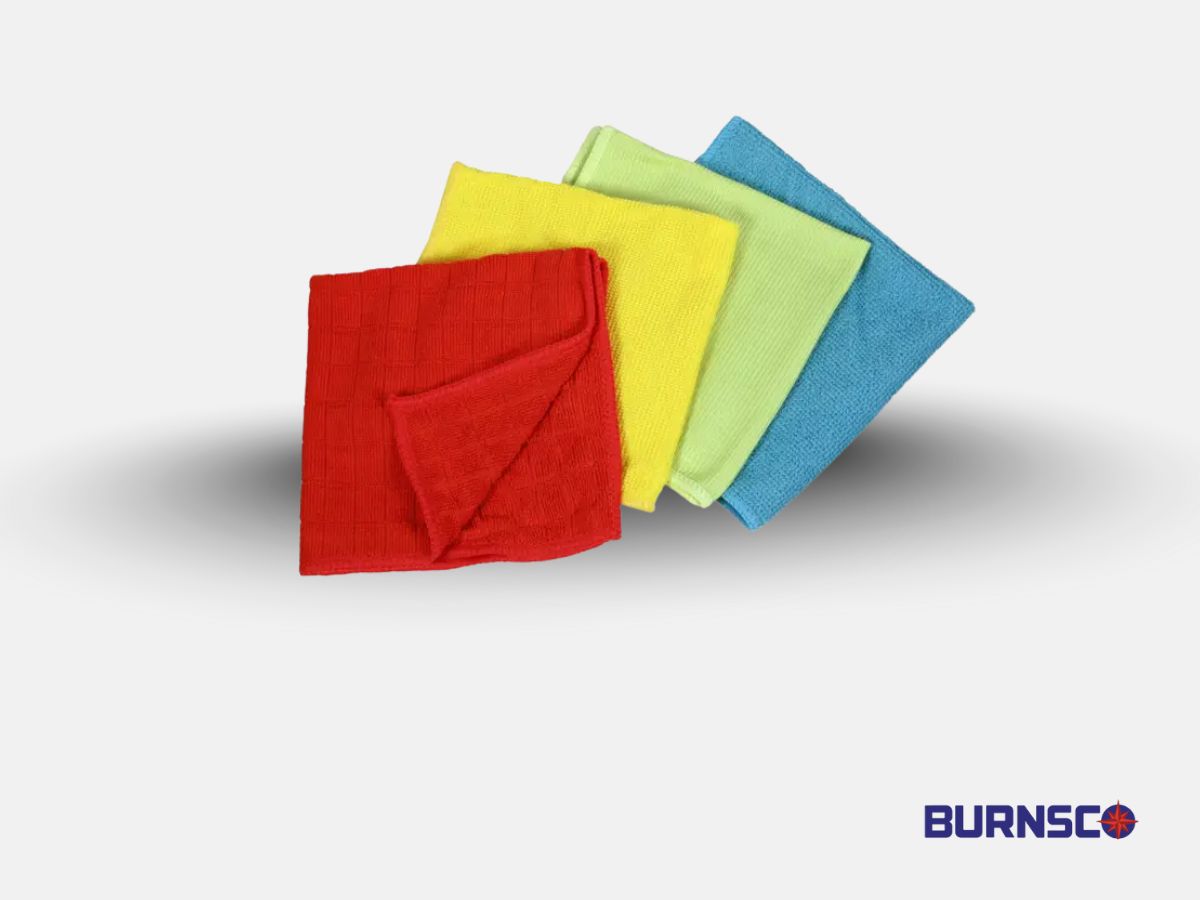
Good care keeps the fun alive. Fresh-smelling inflatables last longer, don’t stink up lockers, and are always ready to launch. A quick rinse and dry means the difference between a season of fun and a pile of burst seams.
Hardware (zips, snaps, frames)
Hardware is the bit no one thinks about until it jams. A salty zip that won’t budge, a corroded snap that tears fabric — they can turn a simple job into a wrestle. Treat them as part of your cleaning routine and they’ll quietly make your life easier.
Steps
- Rinse with fresh water. Wipe zips, snaps, and frames with a microfibre cloth to remove salt before it hardens.
- Lubricate zippers. Spray lightly with silicone lubricant, run the slider back and forth, then wipe excess away.
- Protect snaps. Smear a touch of Vaseline or beeswax on each snap, wiping to spread evenly. This keeps them smooth and rust-free.
- Polish frames. Wipe stainless or aluminium frames with a cloth and fresh water. Once dry, spray with silicone and polish until it beads.
Summary
Smooth zips and snaps are small wins, but they add up. Clean, lubricated hardware prevents breakages, stops smells from building in corroded corners, and makes every cover or dodger that much easier to handle.
Storage and seasonal care
Even perfectly cleaned gear can let you down if you stuff it away damp. Storage is the last line of defence — and the one most people rush. How you pack and protect your gear determines whether you unzip a fresh sail cover next season or a mildewed mess.
Steps
- Dry completely. Always check with a microfibre cloth. If it comes away damp, wait longer.
- Ventilate. Avoid sealed plastic bags. Use mesh or breathable covers and wipe lockers before loading.
- Control odours. Add moisture absorbers or charcoal packs and swap them out regularly.
- Shock treat seasonally. A chlorine-dioxide “Marine Shocker” in enclosed spaces wipes out lingering smells. Follow up with a cloth wipe-down.
- Rotate and inspect. Pull gear out once a season, air it, and check for mildew or damage before re-storing.
Storage is where good habits prove themselves. Dry, ventilated lockers and seasonal checks mean no nasty surprises when covers or cushions come out again. Treat storage seriously and your gear will last longer, cleaner, and with far fewer expensive replacements.
A final word
Living aboard a boat means every surface works harder. Bird droppings on canvas, fish smells in cushions, mildew in dodgers — they’re part of the deal. But they don’t have to linger. With the right routine and the right products, you’ll keep your canvas crisp, your clears bright, and your cockpit welcoming. A little effort now saves a lot later — and makes life afloat far more enjoyable.











